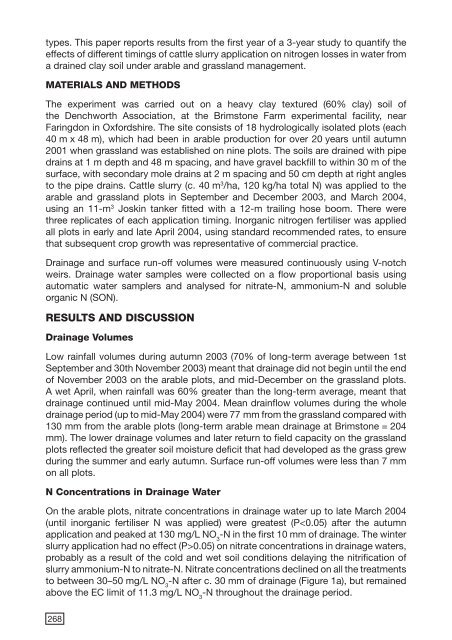Download as a PDF - CiteSeerX
Download as a PDF - CiteSeerX
Download as a PDF - CiteSeerX
Create successful ePaper yourself
Turn your PDF publications into a flip-book with our unique Google optimized e-Paper software.
types. This paper reports results from the first year of a 3-year study to quantify the<br />
effects of different timings of cattle slurry application on nitrogen losses in water from<br />
a drained clay soil under arable and gr<strong>as</strong>sland management.<br />
MATERIALS AND METHODS<br />
The experiment w<strong>as</strong> carried out on a heavy clay textured (60% clay) soil of<br />
the Denchworth Association, at the Brimstone Farm experimental facility, near<br />
Faringdon in Oxfordshire. The site consists of 18 hydrologically isolated plots (each<br />
40 m x 48 m), which had been in arable production for over 20 years until autumn<br />
2001 when gr<strong>as</strong>sland w<strong>as</strong> established on nine plots. The soils are drained with pipe<br />
drains at 1 m depth and 48 m spacing, and have gravel backfill to within 30 m of the<br />
surface, with secondary mole drains at 2 m spacing and 50 cm depth at right angles<br />
to the pipe drains. Cattle slurry (c. 40 m 3 /ha, 120 kg/ha total N) w<strong>as</strong> applied to the<br />
arable and gr<strong>as</strong>sland plots in September and December 2003, and March 2004,<br />
using an 11-m 3 Joskin tanker fitted with a 12-m trailing hose boom. There were<br />
three replicates of each application timing. Inorganic nitrogen fertiliser w<strong>as</strong> applied<br />
all plots in early and late April 2004, using standard recommended rates, to ensure<br />
that subsequent crop growth w<strong>as</strong> representative of commercial practice.<br />
Drainage and surface run-off volumes were me<strong>as</strong>ured continuously using V-notch<br />
weirs. Drainage water samples were collected on a flow proportional b<strong>as</strong>is using<br />
automatic water samplers and analysed for nitrate-N, ammonium-N and soluble<br />
organic N (SON).<br />
RESULTS AND DISCUSSION<br />
Drainage Volumes<br />
Low rainfall volumes during autumn 2003 (70% of long-term average between 1st<br />
September and 30th November 2003) meant that drainage did not begin until the end<br />
of November 2003 on the arable plots, and mid-December on the gr<strong>as</strong>sland plots.<br />
A wet April, when rainfall w<strong>as</strong> 60% greater than the long-term average, meant that<br />
drainage continued until mid-May 2004. Mean drainflow volumes during the whole<br />
drainage period (up to mid-May 2004) were 77 mm from the gr<strong>as</strong>sland compared with<br />
130 mm from the arable plots (long-term arable mean drainage at Brimstone = 204<br />
mm). The lower drainage volumes and later return to field capacity on the gr<strong>as</strong>sland<br />
plots reflected the greater soil moisture deficit that had developed <strong>as</strong> the gr<strong>as</strong>s grew<br />
during the summer and early autumn. Surface run-off volumes were less than 7 mm<br />
on all plots.<br />
N Concentrations in Drainage Water<br />
On the arable plots, nitrate concentrations in drainage water up to late March 2004<br />
(until inorganic fertiliser N w<strong>as</strong> applied) were greatest (P0.05) on nitrate concentrations in drainage waters,<br />
probably <strong>as</strong> a result of the cold and wet soil conditions delaying the nitrification of<br />
slurry ammonium-N to nitrate-N. Nitrate concentrations declined on all the treatments<br />
to between 30–50 mg/L NO 3<br />
-N after c. 30 mm of drainage (Figure 1a), but remained<br />
above the EC limit of 11.3 mg/L NO 3<br />
-N throughout the drainage period.<br />
268

















